Bow making - introduction
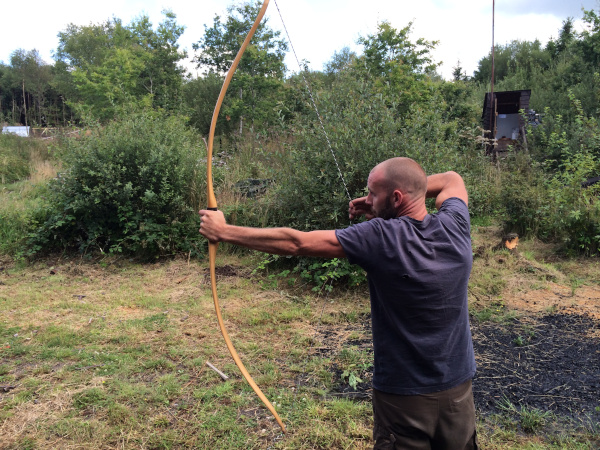
“When I was a child, I wanted to hunt with a bow and arrow like the Stone Age people; to skin deer and build my own shelter. And I desperately wanted a wolf. As we lived in London, my options were limited.” – Michelle Paver
Contents
What is bow making?
Bow making is the construction of a bow – originally a hunting weapon that was the world’s most effective weapon of warfare for several millennia. It consists of a straight piece that’s encouraged to bend with a length of cord to keep it taut, so that it can shoot an arrow.

Types of bow
- Self bow: made entirely from one piece of wood, without any glues or laminating. This is the oldest type of bow
- Hornbow: traditional Asian bow – composite of animal horn & sinew. Animal tendons are dried and combed into fibres, then layered together with animal glue. The horn is fixed to the inside (belly) of the bow, nearest the archer. These kinds of bow can be small but very powerful, and used under tensions that would break a wooden bow. They take much longer and are much more difficult to make than self bows
- Cable-backed bow: the back of Native American / Inuit self bows were sometimes reinforced with animal or plant fibres for increased strength
- Laminated bow: nowadays made of traditional materials like wood, but more usually synthetic, modern materials like fibreglass, laminated in strips and glued together

History
The earliest evidence we have of bows and arrows is from 64,000 years ago, in Southern Africa. There is no evidence of bows themselves, but of stone arrow heads. The oldest bows found in one piece are the 11,000-year-old ‘Holmegaard’ bows from Denmark. In the UK, the oldest bow found is from 4,000 years ago – the Meare Heath bow, found near Salisbury.
The hornbow may be the single biggest reason that the Mongols were able to build the largest empire the world had ever seen in the 14th century, despite having a relatively small population and no great cities. They were superb horsemen and archers, and the small but powerful hornbow was a formidable weapon.
Archery was a very esoteric skill until the introduction of the English longbow from the 14th century. A self bow with a ‘D’ section rather than a flat section, it was usually made from yew. Its size allowed it to be used under high tension by relatively unskilled archers.
In North America, native American bows tended to have a flatter cross-section rather than a ‘D’ shape, and were a lot wider.
The modern sport of archery uses mainly laminated bows made from synthetic materials.

What are the benefits of bow making?
It keeps a traditional skill alive.
In a survival situation, with the right skills you can make a useable bow in 24 hours – you don’t have to season the wood. It could mean the difference between life and death.
In a non-survival situation, the making and using of bows and arrows to harvest food from the wild is a very contentious issue. The arguments against are very simple – either that it’s philosophically wrong for humans to eat animals at all, or that it may not result in a clean kill. If your conscience tells you that it’s wrong to eat animals, then we certainly wouldn’t try to change your mind – we’d agree that the more vegetarians there are the better, and that our current level of meat consumption is too high in terms of sustainability and human health. But not eating meat at all would mean abandoning traditions all over the world that have been practised for many thousands of years. If it ever happens, it’s very unlikely to be soon. So from our perspective, we’d like it to be as sustainable as possible. And we’d argue that the most sustainable way to eat meat is to harvest it from the wild – no removal of habitat for farmland, no chemical fertilisers or pesticides, no hormone treatments, no genetic modification, no growing of animal feeds and no packaging. Also, in many countries, including the UK, deer predators have been reduced in number or removed completely, and so deer grazing prevents the regeneration of forests. If we want forest to return, we have to control deer numbers – and in many places, we are their only predator.

As with several other of our topics around animals, our position is that it’s a disagreement that we can have amongst ourselves whilst still agreeing on the need to live without damaging ecology. At the moment in the UK the debate is academic, as bow hunting is illegal. It became illegal in the sixties, mainly because it’s silent, and therefore perfect for poachers – the law was introduced to benefit big landowners. It’s legal in the States, and in many other countries however. And of course there are still tribes living a traditional way of life in some parts of the word, that involves hunting animals with bows. It’s something they’ve done for tens of thousands of years.
Bowhunting requires much more skill and perseverance than hunting with a rifle. A bowhunter needs to get within 20-30 metres of the prey, which is very difficult indeed – a deer’s senses are much more finely tuned than a human’s. It makes it a much more even contest. Where it’s legal, you need a qualification to be able to hunt with a bow, to demonstrate competency in making a clean kill. Qualifications are offered in the UK by the British Bowhunters’ Association, who also campaign for the re-legalisation of bow hunting. You also have to have a minimum level of power (draw weight) in your bow, and a certain weight and type of arrow (a broad-head), again to ensure a clean kill. A good bow hunter will waste nothing, and will use the skin, antlers and bones as well as the meat.

What can I do?
This section is about making a self bow. Composite bows require a much more specialised form of bowmaking.
First, find a tree. Many types of wood can be used, including ash, hazel, oak, yew, blackthorn, hawthorn and many more. In fact it’s easier to mention the trees that aren’t good for bowmaking – mainly willow, poplar, pine and spruce, which don’t withstand tension or compression well. Look for as straight a tree as possible, around 10-12cm diameter, and cut a log around 150-180cm long. Then split the log into four and use one of the pieces to make a bow, or use all of them to make four bows. The curved outer edge of the log will be the back of the bow, facing away from the archer (the inside of the finished bow is called the ‘belly’). Alternatively, you could make one bow from a sapling.

Dry the timber after splitting, but first seal the ends with varnish or glue to prevent moisture from escaping from the ends, which could cause the wood to split. Ash is probably the best wood to make your first bow with, as it has a low moisture content. You can remove the bark before drying, which will be easier, or you can remove it after drying, which will allow you to get to know the knots and bumps in the wood, which with experience will tell you how the bow is likely to perform. To dry the wood, leave it in a cool, dry place such as an outbuilding or unheated room for at least six months.
Then mark out your bow. At its widest point (either side of the handle) it will be around 5cm. The handle itself will be thinner to allow the arrow to pass. The bow will stay at 5cm wide to 2/3 of the way out from the middle on both sides, then taper down to 2cm towards the ends, and to a point at each end (the ‘knock’). After it’s marked out, you can start to rough it out using an axe, removing quite large amounts of wood. After that, use these tools in order to get to the lines you’ve marked, with a fine finish:
- drawknife
- spokeshave
- rasp
- cabinet scraper
- sandpaper

When cutting your bow to size, don’t cut into the outside of the bow (the ‘back) – you need one continuous growth ring that runs the length of the bow, with all the fibres intact. This will give the bow strength under tension. Keep removing wood from the belly of the bow until you can start to bend the wood. At this point you can use a tillering stick, with notches cut into it at 5cm intervals. String the bow and stretch it on the tillering stick to see if the bend is even, so that you can see where to remove more material. When you’re comfortable with how it pulls, you can add a piece of horn or antler to the knock – the end of each limb – for added strength, and grooves for the string can be cut into it with a chainsaw file.

String
The string for the bow can be made from natural fibre. Linen (from the flax plant) is a traditional bow string fibre. The string is made with at least 12 strands of fibre (more for heavier bows) in a ‘Flemish twist’. I’m not going to try to describe it (imagine writing down how to tie a shoelace) – you have to do it to understand it. A good course should cover it. It produces a loop in the string to fit over the notches in the knock. Wax your string, and you’re ready to go. At least you are once you’ve got some…
Arrows
You can make your own arrows as well – from almost any kind of wood, or even from bamboo. Arrows are most commonly made from hazel saplings, which can be straightened by heating and bending when green. The arrowheads can be made from metal, bone or flint, fixed to the shaft with a linen or sinew wrap. Flight are ideally made from turkey or goose feathers.
Someone who makes bows professionally is called a bowyer; arrows a fletcher; and string a stringfellow.
Specialist(s)
Thanks to Matthew Yung of the Bulworthy Project for information.
The specialist(s) below will respond to queries on this topic. Please comment in the box at the bottom of the page.

Matthew Yung has been teaching bow making since 2013, but his interest in the properties of wood and how they can be harnessed goes back much further. He is a tree surgeon, which has given him an instinctive sense of the structure of wood and how it reacts to external forces. Matthew currently runs courses at the Bulworthy Project.

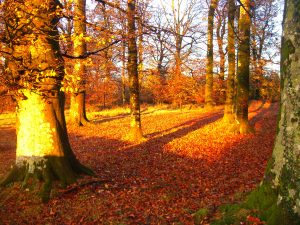
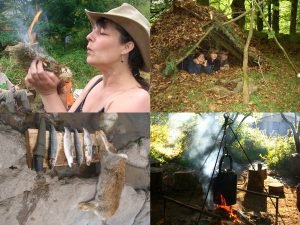
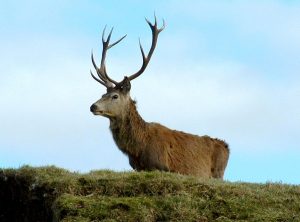
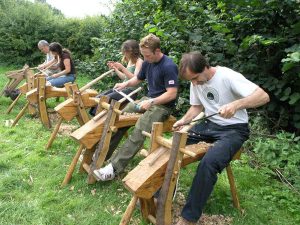
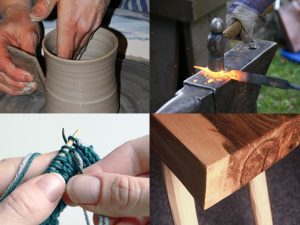
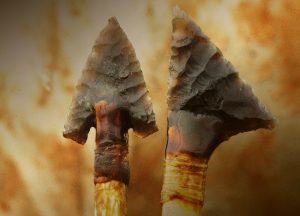
1 Comment
Hi ,
My name is Rose Chen from Oulay archery ,our company is mainly focused on middle-high level archery products .
Epoxy fiberglass is one of our best selling products. We also sell almost all archery products, if you have any needs please feel free to contact me.
Looking forward to your reply.
Best regards,
Rose